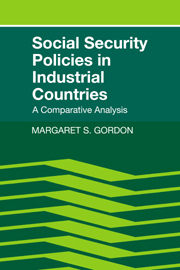Book contents
- Frontmatter
- Contents
- Preface
- Acknowledgments
- Abbreviations
- 1 Postwar developments
- 2 Differences in social security spending
- 3 National old-age pension programs: basic structure
- 4 Other major features of old-age pension programs
- 5 The age of retirement
- 6 Long-term invalidity programs
- 7 Industrial injuries programs
- 8 The role of employer pension plans
- 9 The economic impacts of pension programs
- 10 Health benefits
- 11 Unemployment compensation
- 12 Labor market policies
- 13 Family allowances and family policies
- 14 Public assistance and guaranteed income proposals
- 15 International linkages
- 16 Conclusions
- Appendix 1
- Appendix 2
- References
- Index
14 - Public assistance and guaranteed income proposals
Published online by Cambridge University Press: 06 July 2010
- Frontmatter
- Contents
- Preface
- Acknowledgments
- Abbreviations
- 1 Postwar developments
- 2 Differences in social security spending
- 3 National old-age pension programs: basic structure
- 4 Other major features of old-age pension programs
- 5 The age of retirement
- 6 Long-term invalidity programs
- 7 Industrial injuries programs
- 8 The role of employer pension plans
- 9 The economic impacts of pension programs
- 10 Health benefits
- 11 Unemployment compensation
- 12 Labor market policies
- 13 Family allowances and family policies
- 14 Public assistance and guaranteed income proposals
- 15 International linkages
- 16 Conclusions
- Appendix 1
- Appendix 2
- References
- Index
Summary
Introduction
Modern public assistance is usually the path of last resort for the needy who cannot qualify for benefits from other programs. It is more humane than old poor relief systems, less restrictive in applying the means test, and much less stigmatizing. Moreover, in many countries it is now subject to national standards and wholly or partly financed from national budgets, even though it tends to be administered locally. Nevertheless, it has not altogether lost its stigmatizing tendency, and this, along with ignorance of the provisions, helps to account for the fact that what the British call the “take-up” rate (the proportion of eligible persons who apply for and receive public assistance) tends to be far below 100 percent.
In the Middle Ages, poor relief was the province of the Church and was governed by Canon law. The Church distinguished between the holy voluntary poverty of a St. Francis of Assisi and idle parasitism. It also distinguished between the “able-bodied poor” and those who were poor because they were ailing or too young or too old to work – that is, between the deserving and undeserving poor. It was the duty of the wealthy to provide for the poor – this was the way to heaven. The role of the parish was central in the administration of poor relief, and this was the basis of the important role played by the parish after the Reformation. The medieval hospital also played an important role, as did the lord of the manor, who was expected to care for aging serfs, and the medieval guilds, which had mutual funds to care for ailing and aging members in some cases (Tierney, 1959).
- Type
- Chapter
- Information
- Social Security Policies in Industrial CountriesA Comparative Analysis, pp. 306 - 327Publisher: Cambridge University PressPrint publication year: 1989



